
Ten Of The Best European Berries To Forage
Late summer and early autumn is the berry high season. Berries are easy to spot, often grow in quantity and are relatively easy to collect compared to, say, digging up roots and other underground storage organs. Edible berries generally require little processing yet most are also easily preserved as a jelly, jam or leather. Most of our native berries are overlooked or avoided by the majority of the population, even though much fruit from around the world is bought in supermarkets and enjoyed by many.
There are some great free fruit flavours out there if only you take the time to seek them out. Moreover, many wild berry species are highly nutritious containing not only energy but also many vitamins, minerals and other micronutrients that are hard to find so easily, or in such concentrations, elsewhere. From an historical perspective, a good number of the berries listed here have been important foods, particularly for people not reliant on agricultural crops.
Several of the berries here such as bilberry and cowberry represent very important seasonal food sources for the more northerly peoples of the northern hemisphere. From a bushcraft and survival perspective, all of these berries could augment your diet while out and about. Some also represent important survival foods, particularly those persisting right into the winter months. All of the following berries occur in significant quantities in the UK as well as much of northwestern Europe. Some also occur widely in North America.
Blackberries
Blackberries, the fruit of brambles, Rubus fruticosus agg, are ubiquitous but shouldn’t be dismissed out of familiarity. Yes, they are widespread and common but they are also sweet and flavoursome. Besides, they are a great introduction to foraging, both for kids as well as inexperienced adults wishing to learn about wild foods. Blackberries are a safe starting point for would-be foragers young and old. It’s extremely difficult to confuse these globular compound fruits with anything less benign.
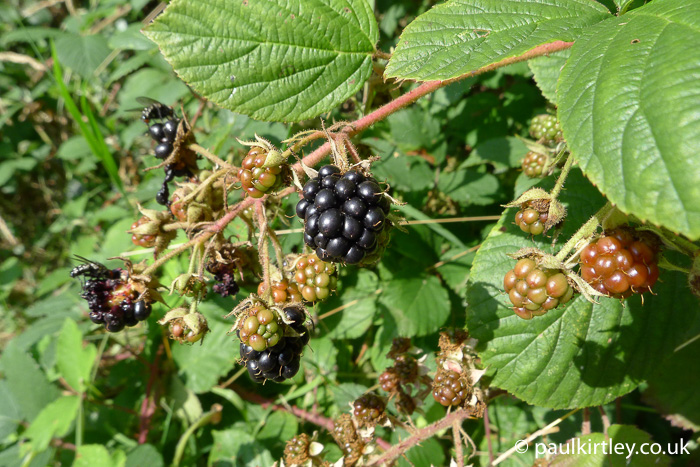
Ripe blackberry fruits are sweet and pleasing to our modern palate. This being said, there is plenty of archaeological evidence that our stone age ancestors also enjoyed these berries in abundance. The season for blackberries is pretty wide, with fruits on the same bush ripening over a period of time. The earliest ripening and often the sweetest and biggest berries are found at the ends of shoots. These should always be picked and enjoyed raw.
Later ripening blackberries are not always so flavoursome but can be added to fruit pies or made into jams for enjoyment through the winter. Blackberries are one of our best and most easily accessible wild fruits.
Raspberries
Ripe raspberries are a foragers delight. The raspberry, Rubus idaeus, like its cousin the blackberry, is an easily-identified composite fruit. Raspberry plants are more upright than brambles, with woody stems but still with prickles, particularly on the greener parts.

These plants tend to form a stand of multiple plants in one area. The undersides of the leaves are a silvery green. Flowers form in drooping clusers towards the ends of the stems and this is, of course, where the fruits later form. The fruits are easily picked from the plant, separating from the plug by which the berry is attached. The berries can be eaten raw or made into jams, added to desserts and puddings or even made into wine.
Red Currants
If you associate berries with autumn, then it’s easy to miss the red currant, Ribes rubrum. These fruits are typically ripe before the end of July, particularly further south. Their season does cross over with raspberries, though, and the combination of these fresh wild fruits is a very good one. The sweetness of the raspberries offsets the acidity of the red currants. Personally I like red currants on their own too but some people find them a little tart to consume in any quantity.
The tartness of red currantes comes from the acidity of the fruit, which contain, amongst other acids, a significant amount of ascorbic acid (vitamin C), with a concentration of about 40mg/100g fruit. Another reason red currants are easily missed is that they tend to be hidden in the darker, damper parts of the woods, often found in association with alder, Alnus glutinosa. The red currant plant is a deciduous shrub, with the woody cane-like stems remaining dormant over the winter.
The leaf, when it appears in spring, resembles that of a maple, with three or five lobes. The fruits are small, about the size of garden peas. If you look closely at these little red jewels, you will notice that the skins are somewhat translucent and in bright sunshine you can see seeds within. You’ll also notice there are lines from stem to base like lines of longitude on a globe. These are features it shares with gooseberries, the family of which currants share.

As well as eating these berries raw, you can make a fine jelly from them, if you can find enough that is. Birds and mice love these berries more than we do. If you have missed them already this year, then make sure they are definitely first on your list to look out for next year.
Bilberries
Bilberries, Vaccinium myrtillus, also known as blaeberries or whortleberries are in the same family as blueberries, which they closely resemble. When ripe they are a dark bluish-black colour with a grey bloom on them, similar to that of some grapes. Bilberry juice stains (for example your fingers or your tongue) a deep bluish-purple colour. The plant is a low-growing shrub with green oval leaves.
It is found covering significant areas on heaths and moors as well as in the woods under pine or oak, particularly in acid soil. The berry is more compact and flavourful than its North American cousins, ripening from August through September. It’s relatively easy to pick a good amount in areas where it is abundant, although some people use specialised berry-catchers to collect the fruits more rapidly.

Despite its excellent taste and historical importance as a food source, the bilberry is largely overlooked these days. This is shame as in addition to being delicious, it contains vitamin C, provitamin A and antioxidants. Bilberry fruits have been shown to have hypoglycaemic and antidiabetic effects ). The fruits can be eaten raw but also added to bannocks, muffins, pies, jams and jellies.
Cowberries
Cowberry, Vaccinium vitis-idaea, is closely related to bilberry but in a number of respects is quite different. The plant is a low-growing, spreading small evergreen shrub. It has glossy oval leaves, turned down around the edges with a lighter underside and visible glands underneath. It’s widespread on moorlands and heaths, often alongside bilberry. The fruits are red and are edible but really quite unpalatable, being very sharp and acidic. Despite this obstacle, the cowberry has been an important food for people of the north, both in Eurasia as well as North America.
In Sweden this berry is called lingon, where a pleasant cordial made from the berries is available. The unpleasant taste of the raw berries comes from the presence of both benzoic acid and oxalic acid.
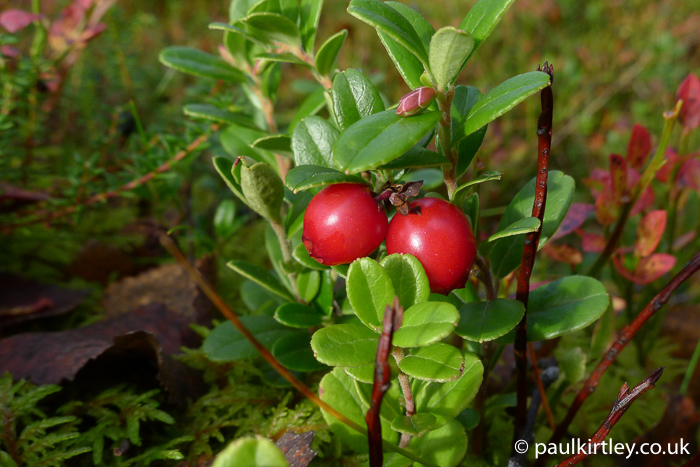
You can make a decent fruit leather from the fruits and with the addition of some pectin from, say, apples a good jelly can be made. Interesting is the fact that the constituent benzoic acid is a natural preservative of the berries, which means, unlike its cousin the bilberry, which is prone to fermentation if stored, cowberries can be easily preserved, even just stored in water.
Elderberries
There are a good number of species of elder, from white-berried species in Australia to near-black species in Europe and North America. There are also red-berried species. Their chemical make-ups varies from species to species, so it’s important to be clear about the species of elder we are discussing. Here we are considering common elder or European elder, Sambucus nigra, widespread throughout the United Kingdom and western Eurasia.
This species is a very common large bush or small tree of woodlands, hedges and scrub. Taking the place of the lacy florets of flowers, the small berries start green then ripen to a dark purple, almost black, hanging down in dense clusters. Sometimes referred to in the past as “the Englishman’s grape”, elder was indeed used to make wine. It has also been used for a range of cordials, sauces, jellies and puddings.
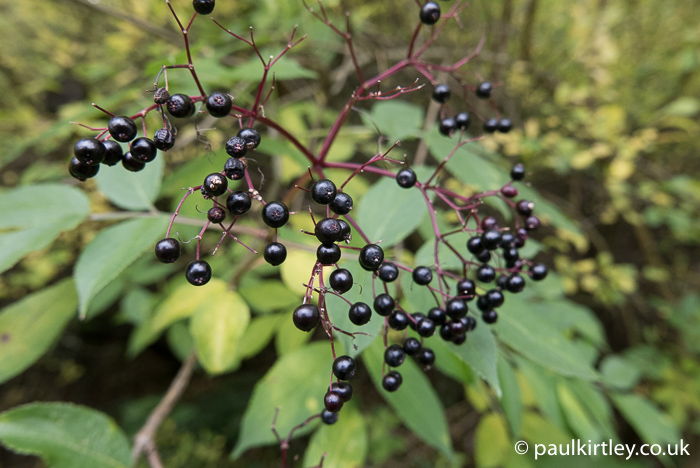
It’s generally recommended the berries shouldn’t be consumed raw, though, certainly not in any great quantity. All green parts of the plant, including the berries, are mildly irritant as well as containing cyanogenic glycosides. There is also a distinctive and somewhat unpleasant sharp smell to the crushed leaves or shoots. Eating quantities of raw berries, particularly if a little unripe, can cause stomach upsets, including nausea and vomiting. The problematic compounds are nullified by heat, so cooking the fruit is always recommended. Strip the berries off the stalks (a fork is handy for this job), discarding the latter. Jams made from mixing the fruit with gooseberries are particularly good.
Rowan
The rowan, or mountain ash, Sorbus aucuparia, is a small- to medium-sized tree native to northern Europe, including the British Isles. It has silvery bark and pinnate, compound leaves, somewhat resembling feathers. Rowan is in the rose family and the fruits bear some resemblance to those of other members of the rose family. Most obvious is that the red fruits look like miniature apples, clustered together in hanging bunches.

Even though they smell quite pleasant when crushed, the taste taste of raw rowan berries is really quite nasty. The berries start to ripen in the south of England in July and August but you’ll often still find them on trees in the north of England and Scotland in October. If you try one or two, you’ll find they are bitter and astringent. They do contain a reasonable amount of ascorbic acid, vitamin C, but also other compounds including malic acid, which makes the berries sour, and parasorbic acid, which causes indigestion and nausea. Heating the berries converts the parasorbic acid to the benign sorbic acid and generally improves the flavour.
In the bush, with no equipment you could place the fruit on a warm rock next to the fire to soften and they will taste better as a result. Or you can make a kind of hot fruit mush, possibly with other berries for added sweetness, in a billy can. The best use of rowan berries, however, is to make a jelly, to which you’ll generally need to add apples for the pectin. Rowan jelly goes very well with pheasant for example. Miles Irving recommends “later rowan is better for flavour and colour”.
Hawthorn
Also in the rose family, hawthorn species all have edible fruits. The most common hawthorn species in the UK is Crataegus monogyna, what most people call just “hawthorn”. It’s a common, widespread and familiar large bush or small tree of woodland understorey, scrub and hedgerows, obvious in the spring due to its abundance of white flowers, often referred to as “May”.
The berries – called haws – ripen around August to a shiny scarlet red. They contain a single stone, which is quite large, so teeth beware. The best way I have found of eating them raw is to place the small fruit in your mouth and nibble away the flesh using your front teeth, before spitting out the pip. The flesh is not particularly sweet, though, tasting quite like the leaves do in the spring.

A much more palate-pleasing way of consuming hawthorn berries is to make a fruit leather. The flavour in transformed and sweetness enhanced by turning them into this tasty fruit jerky. You can also make a decent jelly if you add some crab apples. I’ve heard of people adding the de-seeded fruits to chutney mixes too but I have not tried this myself.
The berries, if not eaten by birds or mice, will stay on the branches for many months, often right into the depths of winter. They turn a less vibrant shade of red over this time and do dry out somewhat as they do so. If you are making a fruit leather with decent haws you’ll notice they are somewhat lacking in moisture as you mush them up, you’ll likely need to add a little water to the pulp. Hawthorn has long been held by herbalists as a cardiac tonic. More recent scientific research has show there is significant potential for hawthorn preparations in the treatment of cardiovvascular disease.
Rosehips
A set of species very obviously part of the rose family are the wild roses in the genus Rosa. All species produce rose-hips, which are the fruits. Rosehips contain hairy seeds in the centre, surrounded by (normally red) flesh that is quite acid to the taste. Rosehips can be consumed raw. Simply remove the hairy seeds, which can be an irritant to the throat, from the centre of each hip, maybe rinsing them a little afterwards. The pulpy flesh is then ready to consume.
Rosehips have long been used in herbal medicine, considered good for coughs and sore throats amongst other things. The hips contain a good amount of ascorbic acid, vitamin C. Indeed during the Second World War, with little or no citrus fruits available in the UK, rosehips became a valuable source of vitamin C in the form of rosehip syrup. Fresh hips contain 0.1-1.0% ascorbic acid – around ten times the concentration found in orange juice.
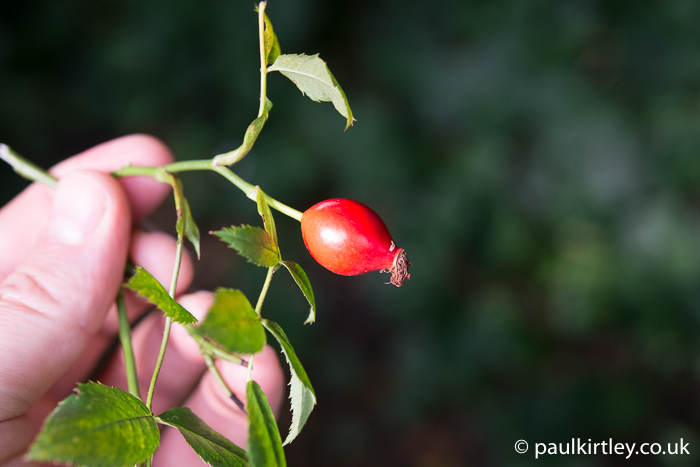
There are many other nutrients in rosehips too. One of my old mentors, Professor Gordon Hillman wrote “In addition to the vitamin C, rosehips contain an impressive array of other nutrients, particularly pro-vitamin A, vitamins of the B group, vitamins P, K and E.” Rose-hip jelly can be made and there is even a Swedish recipe for rosehip soup.
Cherry Plum
The cherry plum, also known as the Myrobalan plum, Prunus cerasifera, is in the same part of the rose family as both cherries and plums. It’s not surprising, then, that it looks a little bit like both, hence the common name. This is an introduced species and the early spring blosson can be hard to distinguish from the native blackthorn, Prunus spinosa. The fruits, however, are distinctive.
Cherry plums are larger than cherries but have a similar overall character and hang on an elongated pedicel (stalk). The fruit is not elongated like a plum but does have a shallow groove down one side, similar to a plum. The fruits are smaller than a typical plum at 20-30mm in diameter. The fruits tend to ripen up to a rich red, although sometimes can be yellow.
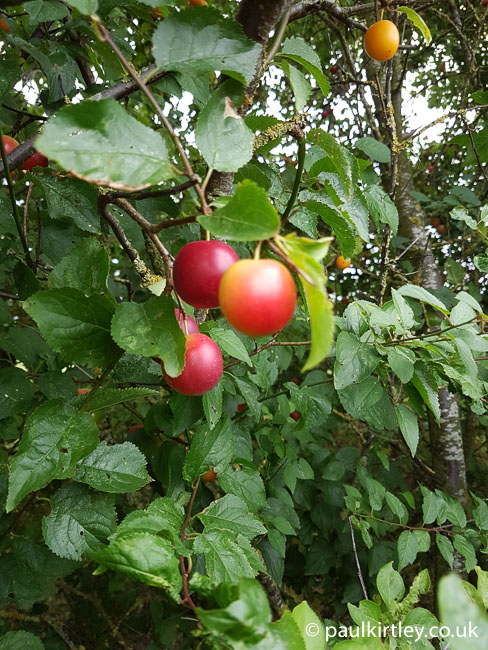
In the UK this species is widespread but the greatest concentration is from the English midlands south. Cherry plums are a small deciduous tree. Although not as spiny, they are similar in overall character to blackthorn and hawthorn, particularly once they have been confined to a hedgerow. The fruits are sweet and tasty when ripe and can be eaten raw like a small plum. They can also be cooked or stewed like other plums.
Don’t forget the apples…
I don’t need to wax lyrical about apples as everyone who has ever been near a grocery or supermarket is familiar with them. That said, modern cultivars are large, juicy and sweet. Wild apples tend to be small, hard and very, very sour. Try a true crab apple and, to quote a friend of mine, “it’ll turn your face inside out!”. Crab and feral apples do contain a good amount of pectin though, which will help set any jam or jelly. So, if you are out and about foraging for other berries, don’t forget the apples…
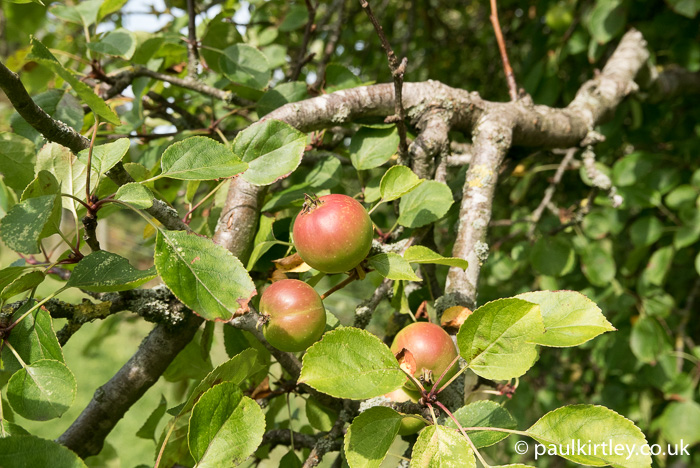
My aim with this article was to encourage even the most reluctant would-be forager to try the more easily recognised of the common berries. For those who are already familiar with the most obvious of berries here, I hope you have been encouraged to try something new, either a species you haven’t tried before or a novel way of preparing or preserving them. Happy berry picking!
Improve Your Tree and Plant Identification Skills
Would you like to improve your ability to identify useful trees and plants? I offer an online tree and plant identification course, which flows through the seasons. Find out more about the next available course by clicking the following link: Paul Kirtley’s Tree and Plant Identification Masterclass
If you liked this article, you’ll also like…
Five Survival Plants Every Forager Should Know
Bark & Buds: How to Easily Identify 12 Common European Deciduous Trees in Winter
12 Easy-To-Forage European Plants For Spring And Early Summer
14 thoughts on “Ten Of The Best European Berries To Forage”
Dear Mr Kirtley, thank you for the most recent email update directing subscribers to your blog on berries. I had no idea that one could eat rosehips raw, without passing the cooked hip through a muslin bag to get rid of hairs. (Can’t be bothered with sourcing muslin bags). I immediately rushed into my garden to sample my own rosehips. Aarg! They contained lots of little black dots. Fungus? Insect eggs? i expect you sre busy, but if you could manage an individual reply I would be most grateful. Cheers, Jay.
Quite a few of these can be found in Canada as well, or variants thereof. Cowberries, blueberries. mountain ash, Elder (yes, Sambuca Nigra), blackberries, raspberries, rosehips, red courants (gooseberries), are all here too, but some in more northerly areas and rocky mountain foothills. They certainly are a welcomed addition to our daily fare, especially when procured by us rather than bought. And, we have nature singing around us as we pick, guaranteed.
Thanks,
Marcel
I really learned from this post and I really appreciate you taking your time and energy to put this together. Thank you!
Thank you for this article. Really looking forward to making rosehip jelly this autumn. Made some Hawthorne fruitleather yesterday. I think it’s quite a hussle to make it, with mushing, separating stone and flesh and drying it out. Is there a trick to it making it easier?
Great work Paul. I am still in there. Been busy training 3 gun dogs. Two and half year old Labrador, six month old Lab and a 18 month old springer Spaniel. Lovining your pod casts. Regards Facemeister
Just had some foraged cherry plums (yellow – from my regular spot) with some other fruit and cream. A good year for cherry plums around here (South Central England). I find the dew berries around here to be less plentiful but sweeter than blackberries. Thanks for the post.
Wonderful to read about some familiar but also some unfamiliar berries. But you forgot my favourite! Sea buckthorn! It’s like British lemons!
Love all these berries! We have most of these growing in our back garden, but my favorite berry is huckleberry which is native to this area. We also have coffee berry (bit of a strong laxative effect so tend to avoid these) and then we have toyon berry, and manzanita berry, both of which are best prepared as fruit leathers. One of the big problems with berry gathering where we live is competing with the wildlife. It’s a time of year when critters big and small come out at night and strip our bushes and trees bare of their fruits.
A really interesting article Paul I enjoyed reading it. I’ve just been out with my forest school group. We foraged blackberries and then cored some apples stuffed the berries inside the gap sprinkled with sugar (just a little!) wrapped them in foil and put them in the embers of our fire. They were delicious and simple. The kids were amazed at how easily you can make hot tasty food on a camp fire. My grandmother always told us to harvest blackberries and elderberries after it has rained. Two reasons: they have been washed and the berries swell to make them more juicy. Love reading your articles.
Hi there. You left out guelder rose (Viburnus opulus) berries – was that deliberate? They are not palatable raw but I make jelly with them every year, usually combined with (crab) apples. It’s a gorgeous clear ruby red and makes a good accompaniment to meat as well as a sweet spread. The odour is slightly odd but don’t be put off by it!
Thanks for another excellent article, Paul. Pleased to see Prunus cerasifera included, it is very common in my area. My mother remembers picking rosehips when she was a child, as part of the “war effort”.
Hi Paul.
Great piece.
I have read this article several times now.
Rowan is one I ALWAYS forget about.
My kids have just sampled bilberry for the first time, and I had a job to get them away from the huge patch of them so we could finish our walk.
Rosehip is one I intend to have a try of this year.
With Rowan Berries, could you use them along with Hawthorn Berries to make a leather, or would it just taste a bit iffy?
Thanks.
Glad you liked it 🙂
Rowan could be added to a leather but it always tastes somewhat bitter unless directly heated.
Warm regards,
Paul
Viburnus opulus